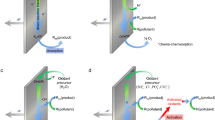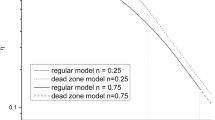Abstract
A mathematical model is developed for the study of the Kolbe oxidative dimerization of acetate to ethane and carbon dioxide in a parallel-plate reactor operating at a fixed cell potential, with hydrogen evolution being the cathode reaction. The volume of gas evolved into the interelectrode gap is tracked by constructing a hypothetical gas layer which increases in thickness with the streamwise direction in a manner determined by solution to the model equations; concurrently, the liquid flows in a hypothetical layer which decreases in thickness. The three-component gas phase is assumed to be ideal, and the liquid phase is an aqueous mixture of five species: acetate, proton, sodium and hydroxyl ions and acetic acid. The model predicts the concentration profiles and the streamwise variation of the gas-void fraction, reaction current density and liquid and gas velocities. Gas evolution causes a decreasing current density in the streamwise direction and an increasing gas and liquid velocity. The concentrations of acetic acid and proton decrease in the streamwise direction, while hydroxyl concentration increases; the decrease in acetate concentration, however, is not significant until the local base-to-acid ratio is near unity because of the buffering effect from undissociated acetic acid. The average current density increases with inlet solution velocity and cell potential and asymptotically approaches the secondary current limit. There exists an optimal interelectrode separation where the cell resistance is minimum. The average current density exhibits a shallow maximum with the baseto-acid ratio of the feed, but decreases precipitously when the ratio is near unity due to the rapid decrease in the proton concentration.
Similar content being viewed by others
Abbreviations
- b a :
-
anodic Tafel constant of the Kolbe reaction of acetate (V)
- b c :
-
cathodic Tafel constant of hydrogen evolution reaction (V)
- c 1 :
-
acetate concentration, mol cm−3
- c 1, ref:
-
reference concentration of acetate (mol cm−3)
- c 2 :
-
acetic acid concentration (mol cm−3)
- c 3 :
-
proton concentration (mol cm−3)
- c 3, ref:
-
reference concentration of proton (mol cm−3)
- c 4 :
-
hydroxyl concentration (mol cm−3)
- C A :
-
stoichiometric concentration of acetic acid in the feed stream (mol cm−3)
- C B :
-
stoichiometric concentration of sodium hydroxide in the feed stream (mol cm−3)
- c B/A :
-
C B/C A, base-to-acid ratio in the feed stream (sodium hydroxide to acetic acid)
- c i(0):
-
concentration of species i at cell inlet (mol cm−3)
- c *i :
-
c i/c A
- E d :
-
decomposition potential (V)
- E oneq,a :
-
standard open-circuit potential of the Kolbe reaction of acetate (V)
- E oeq,a :
-
open-circuit potential of the Kolbe reaction of acetate (V)
- E ceq :
-
standard open-circuit potential of hydrogen evolution reaction (V)
- E eq,e :
-
open-circuit potential of hydrogen evolution reaction (V)
- F :
-
Faraday constant (96 487 C equiv.−1)
- f :
-
gas-void fraction
- h :
-
cell height (cm)
- IR :
-
ohmic-voltage drop in the electrolyte (V)
- i :
-
current density (A cm−2)
- i a,ref :
-
exchange current density of acetate Kolbe reaction at reference concentration (A cm−2)
- i c,ref :
-
exchange current density of hydrogen evolution reaction at a reference concentration (A cm−2)
- i avg :
-
average current density (A cm−2)
- i(0):
-
current density at the inlet of the cell (A cm−2)
- i * :
-
i/i(00)
- Ka:
-
ionization constant of acetic acid (mol cm−3)
- K *a :
-
K a/c A
References
A. V. Vijh and B. E. Conway, Chem. Rev. 67 (1967) 623.
H. Vogt, in ‘Comprehensive Treatise of Electrochemistry’, Vol. 6, E. Yeager (edited by J. O'M. Bockris, B. E. Conway and S. Sarangapani) Plenum, New York (1983).
P. J. Sides, in ‘Modern Aspects of Electrochemistry’, No. 18 (edited by R. E. White J. O'M. Bockris and B. E. Conway) Plenum, New York (1986).
F. Beck, Electrochim. Acta 18 (1972) 359.
M. Seko, A. Yomiyama and T. Isoya, Hydrocarbon Processing, No. 12 (1979) 117.
Y. B. Vassiliev, E. P. Kosvman and G. N. Freidlin, Electrochim. Acta 27 (1982) 937.
J. E. Funk and J. F. Thorpe, J. Electrochem. Soc. 116 (1969) 48.
Yu. B. Vassiliev and V. A. Grinberg, J. Electroanal. Chem. 308 (1991) 1.
W. E. Ryan, R. E. White and S. L. Kelly, ibid. 134 (1987) 2154.
J. F. Yan, T. V. Nguyen, R. E. White and R. B. Griffin, ibid. 140 (1993) 733.
R. E. Meredith and C. Tobias, in ‘Advances in Electrochemistry and Electrochemical Engineering’, Vol. 2 (edited by C. Tobias), Interscience Publishers, New York (1962).
‘FORTRAN Subroutine for Mathematical Applications’, IMSL, Math/Library, Houston, TX (1987).
H. H. Uhlig and R. W. Revie, ‘Corrosion and Corrosion Control’, 3rd. edn., John Wiley & Sons, New York (1985).
A. V. Vijh and B. E. Conway, Z. Anal. Chem. 224 (1967) 160.
S. H. Maron and J. B. Lando, ‘Fundamentals of Physical Chemistry’, Macmillan, New York (1974).
C. W. Tobias, J. Electrochem. Soc. 106 (1959) 833.
Z. Nagy, J. Appl. Electrochem. 6 (1976) 171.
Y. Nishiki, K. Aoki, K. Tokuda and H. Matsuda, J. Appl. Electrochem. 16 (1986) 615.
Author information
Authors and Affiliations
Rights and permissions
About this article
Cite this article
Yan, J.F., Fedkiw, P.S. & Law, C.G. A model for the Kolbe reaction of acetate in a parallel-plate reactor. JOURNAL OF APPLIED ELECTROCHEMISTRY 26, 175–185 (1996). https://doi.org/10.1007/BF00364068
Received:
Revised:
Issue Date:
DOI: https://doi.org/10.1007/BF00364068




